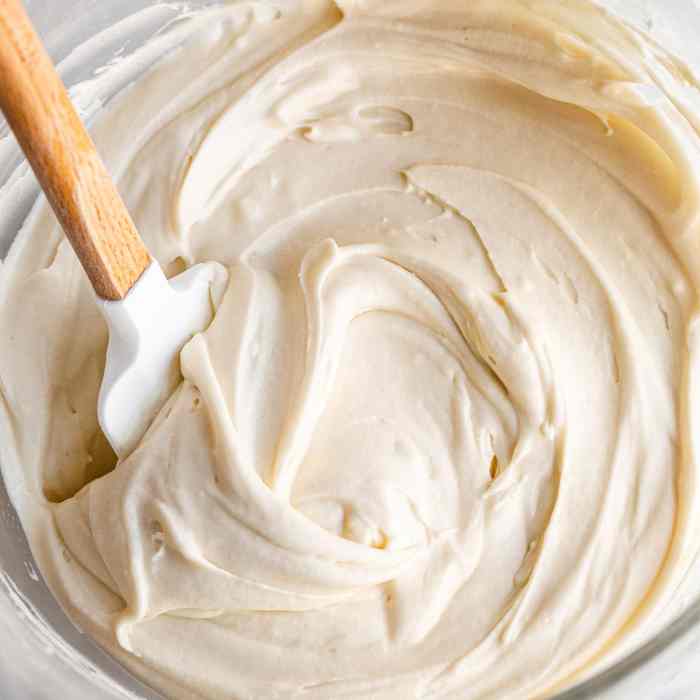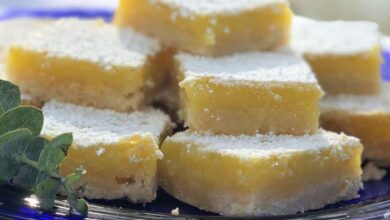
What Is Cream Cheese: A Creamy Journey Through History and Flavor
What is cream cheese? It’s more than just a spread for bagels. It’s a creamy, tangy delight that’s been enjoyed for centuries, and its versatility knows no bounds. From its humble beginnings in Europe to its widespread popularity today, cream cheese has captured the hearts and palates of food lovers around the globe.
Cream cheese is a soft, spreadable cheese made from cow’s milk that’s been cultured and strained. It’s known for its smooth texture, mild tang, and subtle sweetness. But cream cheese is more than just a flavor; it’s a canvas for culinary creativity.
Whether you’re indulging in a classic cheesecake, adding a touch of richness to a savory dish, or simply spreading it on a bagel, cream cheese offers a unique and satisfying experience.
Introduction to Cream Cheese: What Is Cream Cheese

Cream cheese, a beloved staple in kitchens worldwide, has a rich history and a unique character that makes it a versatile ingredient. It’s a soft, spreadable cheese with a creamy texture and a mild, slightly tangy flavor.
Origins and History of Cream Cheese
The origins of cream cheese can be traced back to the 18th century in Europe. While its exact birthplace is debated, it is believed to have emerged in France or Germany. During this period, cheesemakers were experimenting with different techniques for making cheese, and cream cheese likely arose as a byproduct of these explorations.
Early recipes for cream cheese often involved simply separating the cream from milk and allowing it to sour naturally, then draining off the excess whey. This process resulted in a soft, spreadable cheese that was often used as a topping for bread or pastries.Cream cheese’s popularity grew in the 19th century, especially in the United States.
The invention of the cream separator, which efficiently separated cream from milk, made the production of cream cheese more efficient and widespread.
Definition of Cream Cheese
Cream cheese is a soft, spreadable cheese made from cream or a combination of cream and milk. It is typically made by culturing pasteurized cream or a mixture of cream and milk with lactic acid bacteria, which adds a tangy flavor and a slightly acidic pH.
The resulting mixture is then drained to remove excess whey, resulting in a thick, creamy cheese.
Characteristics of Cream Cheese
Cream cheese is known for its distinct characteristics, including its texture, flavor, and color:
- Texture:Cream cheese has a smooth, spreadable texture that is soft and creamy. Its consistency can vary depending on the fat content and the aging process.
- Flavor:Cream cheese has a mild, slightly tangy flavor that is not overly sharp. The tanginess is due to the lactic acid produced by the bacteria used in the cheesemaking process.
- Color:Cream cheese is typically white or pale ivory in color. Its color can vary slightly depending on the type of milk used and the aging process.
Production Process
Cream cheese production involves a series of carefully controlled steps to transform milk into the creamy, spreadable cheese we know and love. This process involves specific techniques and ingredients to achieve the desired texture and flavor profile.
Milk Types, What is cream cheese
The type of milk used in cream cheese production significantly influences its final characteristics.
- Cow’s Milk:This is the most common milk used for cream cheese. It provides a rich, creamy texture and a mild flavor.
- Goat’s Milk:Goat’s milk produces a cream cheese with a tangier flavor and a slightly crumbly texture. It is also a good option for individuals with dairy allergies or intolerances.
- Sheep’s Milk:Sheep’s milk cream cheese has a strong, distinct flavor and a dense, rich texture.
- Buffalo Milk:Buffalo milk cream cheese is known for its unique, slightly sweet flavor and its smooth, creamy texture.
Role of Cultures and Enzymes
Cultures and enzymes play crucial roles in cream cheese production.
- Cultures:Cultures are live bacteria that are added to the milk. These bacteria ferment the lactose (milk sugar) into lactic acid, which gives cream cheese its tangy flavor and helps to solidify the milk proteins.
- Enzymes:Enzymes are proteins that break down the milk proteins, making the cheese smoother and easier to spread. Rennet, an enzyme derived from animal stomachs, is commonly used in cream cheese production.
Production Steps
Here are the key steps involved in cream cheese production:
- Milk Preparation:The milk is pasteurized to kill harmful bacteria and then standardized to achieve the desired fat content.
- Cultures and Enzymes:Cultures and enzymes are added to the milk, initiating the fermentation process.
- Curdling:The milk curdles, forming solid curds and a liquid whey. This process is typically accelerated by heating the milk.
- Cutting and Draining:The curds are cut into smaller pieces to facilitate whey drainage. The whey is then drained off, leaving behind the concentrated curds.
- Mixing and Blending:The curds are mixed and blended to create a smooth, creamy texture.
- Salting and Packaging:Salt is added to the cream cheese to enhance its flavor and preserve it. The cream cheese is then packaged and ready for distribution.
Types of Cream Cheese
Cream cheese comes in various forms, each with its own unique characteristics and uses. Understanding the different types allows you to select the perfect cream cheese for your culinary needs, whether you’re spreading it on a bagel, whipping it into a dip, or using it as a base for cheesecake.
Cream Cheese Varieties
Cream cheese varieties are categorized based on their fat content, texture, and flavor profile. Here’s a breakdown of the most common types:
| Type | Fat Content (%) | Flavor Profile | Common Uses |
|---|---|---|---|
| Traditional Cream Cheese | 33-35 | Rich, buttery, slightly tangy | Spreading on bagels, making dips, cheesecakes |
| Reduced-Fat Cream Cheese | 15-20 | Milder flavor, less rich | Spreading on bagels, dips, baking |
| Whipped Cream Cheese | 33-35 | Same as traditional, but lighter and fluffier | Spreading on bagels, dips, topping desserts |
| Cream Cheese Spread | 25-30 | Often flavored with herbs, spices, or fruits | Spreading on crackers, bagels, sandwiches |
| Mascarpone | 75-80 | Rich, buttery, sweet | Tiramisu, filling pastries, sauces |
| Philadelphia Cream Cheese | 33-35 | Classic, tangy, smooth | Spreading on bagels, cheesecakes, dips |
“Cream cheese is a versatile ingredient that can be enjoyed in a variety of ways, from sweet to savory applications.”
Nutritional Value

Cream cheese, a staple in many cuisines, offers a unique flavor and texture, but it’s important to understand its nutritional profile to make informed dietary choices.
Cream cheese is a soft, spreadable cheese made from cow’s milk. It’s a staple in many kitchens, and its versatility shines in both sweet and savory dishes. If you’re looking for a comforting and delicious soup recipe, try this creamy chicken gnocchi soup that uses cream cheese to add a rich, smooth texture.
Cream cheese, with its mild flavor and creamy consistency, is a great ingredient to keep on hand for all kinds of culinary adventures.
Nutritional Content of Cream Cheese
Cream cheese is primarily composed of fat, with a significant amount of saturated fat. It also contains protein, carbohydrates, and some vitamins and minerals. However, it’s relatively low in fiber and has a high calorie density.
Benefits of Consuming Cream Cheese
While cream cheese is high in fat, it also provides some nutritional benefits:* Source of Calcium:Cream cheese contains a moderate amount of calcium, an essential mineral for strong bones and teeth.
Provides Vitamin A
Cream cheese offers a small amount of vitamin A, important for vision, immune function, and cell growth.
Good Source of Protein
Cream cheese contributes to your daily protein intake, essential for muscle building and repair.
Potential Drawbacks of Consuming Cream Cheese
Due to its high fat content, consuming cream cheese in excess can contribute to:* Increased Risk of Heart Disease:Saturated fat can raise LDL cholesterol levels, increasing the risk of heart disease.
Weight Gain
Cream cheese, that tangy, spreadable delight, is a staple in many kitchens. It’s a key ingredient in cheesecakes, dips, and even some savory dishes like the classic retro ground beef casserole with biscuits. Speaking of that casserole, the creamy, cheesy sauce is what makes it so comforting and nostalgic.
And yes, that creamy sauce is, you guessed it, made with cream cheese!
Cream cheese is calorie-dense, and excessive consumption can lead to weight gain.
Sodium Content
Cream cheese can be high in sodium, which can contribute to high blood pressure in some individuals.
Cream cheese is a soft, spreadable cheese that’s often used in cheesecakes, dips, and even savory dishes like this instant pot Thai style green curry chicken. While it might seem like an unusual addition to a savory dish, the creamy texture and tangy flavor of cream cheese actually complement the rich coconut milk and aromatic spices in this curry beautifully.
It’s a great way to add a touch of richness and creaminess to your next Thai-inspired meal.
Macronutrients, Vitamins, and Minerals in Cream Cheese
The following table provides a breakdown of the macronutrients, vitamins, and minerals found in a typical serving of cream cheese (1 ounce):
| Nutrient | Amount (per 1 ounce) |
|---|---|
| Calories | 100 |
| Fat | 9 grams |
| Saturated Fat | 5 grams |
| Protein | 2 grams |
| Carbohydrates | 2 grams |
| Sugar | 1 gram |
| Calcium | 20 mg |
| Vitamin A | 100 IU |
Culinary Applications
Cream cheese, with its rich and creamy texture, is a versatile ingredient that finds its way into countless dishes, from savory appetizers to decadent desserts. It adds a unique tanginess and richness that complements a wide array of flavors.
Savory Dishes
Cream cheese’s versatility extends beyond sweet treats. It can be incorporated into savory dishes, adding a creamy and tangy element to appetizers, dips, and even main courses.
- Appetizers:Cream cheese is a staple in appetizers. It’s often used as a base for dips, spreads, and fillings. For example, classic cream cheese and onion dip, or a simple spread with smoked salmon and capers.
- Main Courses:Cream cheese can be incorporated into main courses, adding richness and creaminess.
A popular example is chicken or salmon enchiladas, where cream cheese is used as a filling along with other ingredients.
Desserts
Cream cheese is a beloved ingredient in a wide variety of desserts, contributing its signature tanginess and creamy texture.
Cream cheese-based desserts are popular for their creamy texture and tangy flavor. Some popular examples include:
- Cheesecake
- Cream cheese frosting
- No-bake cheesecakes
- Cheesecake bars
- Cream cheese cookies
Storage and Shelf Life
Cream cheese is a perishable dairy product, so it’s crucial to store it properly to maintain its quality and prevent spoilage. Proper storage can extend its shelf life and ensure it remains safe for consumption.
Storage Methods
Storing cream cheese correctly is essential for maintaining its freshness and preventing spoilage. Here are the recommended storage methods:
- Refrigeration:Cream cheese should always be stored in the refrigerator at a temperature of 40°F (4°C) or below. This temperature range helps slow down bacterial growth and preserves the cheese’s texture and flavor.
- Original Packaging:It’s best to keep cream cheese in its original packaging, as this helps prevent moisture loss and contamination. If the packaging is damaged, you can transfer it to an airtight container or wrap it tightly in plastic wrap.
- Freezing:Cream cheese can be frozen for up to 2 months, but it may lose some of its creamy texture after thawing. To freeze cream cheese, wrap it tightly in plastic wrap and aluminum foil. Thaw it in the refrigerator overnight before using it.
Factors Affecting Shelf Life
Several factors influence the shelf life of cream cheese, including:
- Type of Cream Cheese:Some types of cream cheese, such as whipped cream cheese, have a shorter shelf life than others, like full-fat cream cheese.
- Storage Conditions:Storing cream cheese at temperatures above 40°F (4°C) can significantly shorten its shelf life. Exposure to light and air can also contribute to spoilage.
- Packaging:Damaged or improperly sealed packaging can allow bacteria to enter and contaminate the cream cheese.
Determining if Cream Cheese Has Gone Bad
It’s important to know how to determine if cream cheese has spoiled to avoid consuming it. Here are some signs to look for:
- Off Odor:Spoiled cream cheese will have a sour or rancid odor.
- Change in Texture:Cream cheese that has gone bad will become watery, slimy, or moldy.
- Discoloration:Spoiled cream cheese may have a yellow or greenish discoloration.
- Taste:Spoiled cream cheese will have a sour or bitter taste.
If you notice any of these signs, it’s best to discard the cream cheese.
Cream Cheese Alternatives
Cream cheese, with its rich, tangy flavor and creamy texture, has become a staple in many kitchens. But for those who are dairy-sensitive, vegan, or simply seeking alternatives, there are numerous options available. This section explores both dairy-based and non-dairy alternatives to cream cheese, comparing their characteristics and highlighting their potential benefits and drawbacks.
Dairy-Based Alternatives
Dairy-based alternatives are typically made from milk and cream, but with modifications to address specific dietary needs or preferences.
- Reduced-Fat Cream Cheese: As the name suggests, reduced-fat cream cheese contains less fat than traditional cream cheese, resulting in a lower calorie and fat content. While it might be slightly less creamy, it still offers a similar tangy flavor.
- Greek-Style Cream Cheese: This alternative boasts a thicker, more tangy flavor than traditional cream cheese.
It is made with strained yogurt, giving it a higher protein content and a less creamy texture.
- Cream Cheese Spread: This option often incorporates ingredients like sour cream, buttermilk, or yogurt to create a smoother, more spreadable texture. It may also have a slightly milder flavor compared to traditional cream cheese.
Non-Dairy Alternatives
Non-dairy alternatives are gaining popularity, catering to vegan and lactose-intolerant individuals. They are typically made from plant-based ingredients like cashews, almonds, or tofu.
- Cashew-Based Cream Cheese: This alternative is known for its creamy texture and rich flavor. Cashews are soaked and blended to create a smooth, spreadable consistency.
- Almond-Based Cream Cheese: Made from almonds, this alternative offers a slightly nutty flavor. It is often blended with other ingredients like coconut oil or tapioca starch to achieve a creamier texture.
- Tofu-Based Cream Cheese: Tofu is a versatile ingredient that can be used to create a surprisingly creamy alternative to cream cheese. It is often blended with other ingredients like nutritional yeast or lemon juice to enhance its flavor.
Comparison of Taste, Texture, and Nutritional Value
| Type | Taste | Texture | Nutritional Value |
|---|---|---|---|
| Traditional Cream Cheese | Rich, tangy | Creamy, smooth | High in fat and calories, good source of protein and calcium |
| Reduced-Fat Cream Cheese | Similar to traditional, but slightly less creamy | Slightly less creamy | Lower in fat and calories than traditional |
| Greek-Style Cream Cheese | Thicker, more tangy | Thicker, less creamy | Higher in protein than traditional |
| Cream Cheese Spread | Milder flavor | Smoother, more spreadable | May contain less fat and calories than traditional |
| Cashew-Based Cream Cheese | Rich, creamy | Smooth, spreadable | High in healthy fats, good source of protein and fiber |
| Almond-Based Cream Cheese | Slightly nutty | Creamy | High in healthy fats, good source of vitamin E |
| Tofu-Based Cream Cheese | Mild, slightly tangy | Creamy | Good source of protein and calcium |
Benefits and Drawbacks of Using Cream Cheese Alternatives
- Dairy-Free: Non-dairy alternatives offer a suitable option for individuals with lactose intolerance or those following a vegan diet.
- Reduced Fat and Calories: Reduced-fat cream cheese and some non-dairy alternatives can be a lower-calorie and lower-fat option compared to traditional cream cheese.
- Higher Protein: Greek-style cream cheese and some non-dairy alternatives can provide a higher protein content.
- Potential for Allergies: Some individuals may be allergic to nuts, soy, or other ingredients commonly found in non-dairy alternatives.
- Taste and Texture Variations: The taste and texture of alternatives can vary depending on the ingredients and production methods used.






